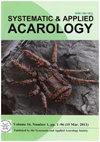伪边缘新绥螨(Neoseiulus pseudomarginatus sp. nov.),地中海国家一新种掠食性螨(蜱螨亚纲:植绥螨科)一直被误认为边缘新绥螨(Neoseiulus marginatus, Wainstein)
IF 1.2
3区 农林科学
Q2 ENTOMOLOGY
引用次数: 1
摘要
摘要:以往对蜱螨科物种的描述缺乏一些重要的形态学特征,包括背侧腺孔的数量。然而,在一些植物属(如Kampimodromus Nesbitt和Neoseiulus Hughes)中,单对单孔口的存在或缺失对于识别两个不同物种的重要性已经在几个案例中得到了分子研究的证实。Neoseiulus marginatus (Wainstein)最初是在中亚国家哈萨克斯坦根据采集的草本植物标本被描述的。随后,它被报道并重新描述了一系列西方古北极国家。然而,首先从克里米亚重新描述的材料,随后从亚美尼亚、希腊、以色列和土耳其重新描述的材料,由于具有gd5 solenostomes,与Wainstein描述的原始N. marginatus不同。事实上,我们对其模式标本的研究证实,在边缘N.类型系列中一直没有gd5孔。因此,对该物种进行了重新描述,并以雌性为基础进行了说明。此外,本文还将广分布于古北西部国家的pseudoomarginatus sp. nov.描述为具有7对独口器的新分类单元。此外,我们对N. polyporus (Wainstein)模式标本的研究表明,它应该被认为是N. marginatus的低级同义种,这已经在早期的研究中提出了。本文章由计算机程序翻译,如有差异,请以英文原文为准。
Neoseiulus pseudomarginatus sp. nov., a new species of predatory mites (Acari: Phytoseiidae) continuously misidentified as Neoseiulus marginatus (Wainstein) from the Mediterranean countries
Abstract Many previous descriptions of Phytoseiidae (Acari: Mesostigmata) species lack some important morphological characteristics including the number of dorsal solenotomes (gland pores). However, the importance of the presence or absence of a single pair of solenostomes to identify two distinct species in some phytoseiid genera, such as Kampimodromus Nesbitt and Neoseiulus Hughes has previously been confirmed by molecular studies in several cases. Neoseiulus marginatus (Wainstein) was originally described from Kazakhstan, a country located in Central Asia, based on the specimens collected from herbaceous plants. It was subsequently reported and redescribed from a series of Western Palearctic countries. However, the material first redescribed from Crimea and thereafter from Armenia, Greece, Israel, and Turkey, by having gd5 solenostomes, is distinct from the original N. marginatus described by Wainstein. Indeed, our examinations of its type specimens confirmed that gd5 pores are consistently absent in the type series of N. marginatus. Therefore, this species is redescribed and illustrated based on the female lectotype. In addition, N. pseudomarginatus sp. nov., a widely distributed species in the Western Palearctic countries, which has seven pairs of solenostomes is described as a new taxon for science. Furthermore, our examinations of the type specimens of N. polyporus (Wainstein) indicated that it should be considered as a junior synonym of N. marginatus, as already suggested in earlier studies.
求助全文
通过发布文献求助,成功后即可免费获取论文全文。
去求助
来源期刊

Systematic and Applied Acarology
ENTOMOLOGY-
CiteScore
2.20
自引率
33.30%
发文量
152
期刊介绍:
Systematic and Applied Acarology (SAA) is an international journal of the Systematic and Applied Acarology Society (SAAS). The journal is intended as a publication outlet for all acarologists in the world.
There is no page charge for publishing in SAA. If the authors have funds to publish, they can pay US$20 per page to enable their papers published for open access.
SAA publishes papers reporting results of original research on any aspects of mites and ticks. Due to the recent increase in submissions, SAA editors will be more selective in manuscript evaluation: (1) encouraging more high quality non-taxonomic papers to address the balance between taxonomic and non-taxonomic papers, and (2) discouraging single species description (see new special issues for single new species description) while giving priority to high quality systematic papers on comparative treatments and revisions of multiple taxa. In addition to review papers and research articles (over 4 printed pages), we welcome short correspondence (up to 4 printed pages) for condensed version of short papers, comments on other papers, data papers (with one table or figure) and short reviews or opinion pieces. The correspondence format will save space by omitting the abstract, key words, and major headings such as Introduction.
 求助内容:
求助内容: 应助结果提醒方式:
应助结果提醒方式:


